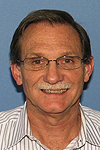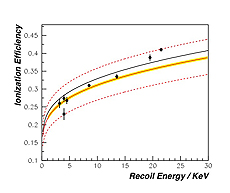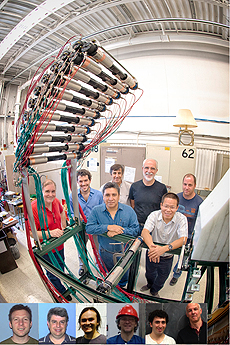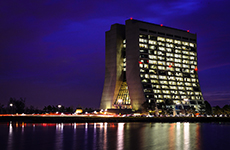|
Have a safe day!
Friday, Nov. 21
3:30 p.m.
Director's Coffee Break - WH2XO
4 p.m.
Joint Experimental-Theoretical Physics Seminar - One West
Speaker: Simona Murgia, University of California, Irvine
Title: Indirect Dark Matter Searches with Gamma Rays: Constraints and Intriguing Hints
Monday, Nov. 24
2 p.m.
Particle Astrophysics Seminar - Curia II
Speaker: Juan Estrada
Title: MKIDs at Fermilab: From Detector R&D to Dark Energy Science
3:30 p.m.
Director's Coffee Break - WH2XO
4 p.m.
All Experimenters' Meeting - Curia II
Visit the labwide calendar to view Fermilab events
|
|
Friday, Nov. 21
- Breakfast: Blueberry-stuffed French toast
- Breakfast: chorizo and egg burrito
- Beer-braised bratwurst
- Roasted salmon caponata
- Liver and onions
- Baked ham and cheese ciabatta
- Boneless wing bar
- Texas-style chili
- Wisconsin beer and cheese soup
- Assorted pizza by the slice
Wilson Hall Cafe menu
|
|
Friday, Nov. 21
Dinner
- Spinach, mandarin orange and red onion salad
- Mahi mahi with avocado tomatillo salsa
- Lemongrass rice
- Sauteed pea pods
- Coconut flan
Wednesday, Nov. 26
Lunch
- Cheese fondue
- Mixed greens salad
- Strawberry almond tart
Chez Leon menu
Call x3524 to make your reservation.
|
|
December wellness offerings, fitness classes and discounts
Complimentary Wellness
Girls Fight Back
Tuesday, Dec. 2
noon-1 p.m.
Wilson Hall, One West
Girls Fight Back is a live 60-minute seminar with a goal of teaching women of all ages the basics of personal safety and self-defense. Delivered in a fun and “edu-taining” format, this presentation has been seen by more than 1 million women since 2001.
10-Minute Stress Relief Chair Massages
Thursday, Dec. 4, 11 a.m.-1 p.m.
Wilson Hall, Small Dining Room
Reserve your free 10-minute chair massage by emailing Jeanne Ecker at x2548.
Fitness Classes
Ultimate Core
Wednesdays, Dec. 3, 10 and 17
noon-12:45 p.m.
Fitness Center Exercise Room
Fee: $30. Register by Nov. 26.
Zumba Toning
Tuesdays, Dec. 9-Jan. 20
noon-12:45 p.m.
Fitness Center Exercise Room
Fee: $45. Register by Dec. 2.
Zumba Fitness
Thursdays, Dec. 11-Jan. 22 (no class Dec. 25 or Jan. 1)
noon-12:45 p.m.
Fitness Center Exercise Room
Fee: $35. Register by Dec. 4.
Mat Pilates
Mondays, Jan. 5-Feb. 16 (no class Jan. 19)
noon-12:45 p.m.
Fitness Center Exercise Room
Fee: $65. Register by Dec. 29.
Yoga Mondays
Mondays, Jan. 5-Feb. 23 (no class Jan. 19)
noon-12:45 p.m.
WHGFE Training Room
Fee: $55. Register by Dec. 29.
Yoga Thursdays
Thursdays, Jan. 8-Feb. 26
noon-12:45 p.m.
WHGFE Training Room
Fee: $60. Register by Dec. 30.
Ultimate Core
Fridays, Jan. 9-Feb. 13
noon-12:45 p.m.
Fitness Center Exercise Room
Fee: $60. Register by Jan. 2.
Athletic Leagues
Broomball Open League
Broomball is an outdoor, year-round, all-weather (except lightning) sport. Think field hockey but played with homemade "brooms" and a large tennis ball. Games are played on an open basis in the Village, either on the soccer field or the Blackhawk Glade between Blackhawk Blvd. and Shabonna St. Games usually take place from 12:15-12:45 p.m. Contact Chris Greer at x4847 for more information and to be added to the daily sign-up list.
Open Basketball
Wednesdays, 6:30-9 p.m.
Fitness Center. Gym membership required.
Contact Junhui Liao for more information.
Employee Discount
AMC and Regal Cinema
For more discounts, visit the employee discount Web page.
|
John Tompkins, Technical Division, retires from Fermilab
 |
|
John Tompkins
|
It is a common rule that a trained high-energy physicist contributes to many different aspect of his lab's physics program. John Tomkins is a confirmation of this rule. Now we wish him well as he enters retirement.
As grad student from UCLA in 1972, John went to the USSR to work on a 70-GeV proton accelerator in Russia, the most powerful in the world at that time. He was one of the first Americans to visit the Institute of High Energy Physics in Protvino. In 1974, John continued his research at Fermilab, collaborating on the E216 experiment.
As the Superconducting Super Collider was getting started in 1987, John was recruited in the Central Design Group, leading a team of physicists responsible for testing superconducting magnets. During this period he often traveled to Fermilab to visit the Technical Support Section (now the Technical Division), participating in the testing of the first SSC dipoles. After the closing of the SSC project, John was hired by Fermilab in 1994. As he often joked, previous Fermilab director John Peoples fired him from the SSC and hired him to work at Fermilab.
John helped build the Development and Test Department, which played a key role in the development, testing, precision measurements and analysis of all types of accelerator magnets. He helped develop magnets for the Fermilab Main Injector and Recycler and for the LHC model magnet program. He worked to advance the niobium-3-tin high-field magnet frontier and advocated for the development of new magnetic measurement systems.
In 2007, John led the ILC Americas Magnet Systems organization, a multilab and university coalition. Afterwards, he capably led efforts to develop superconducting magnets for the HINS R&D project, which was later redirected to become Project X R&D, and played a major role in the Very High Field Superconducting Magnet Collaboration. Later, he became a manager for the MAP project.
"John has always been an excellent and discerning supervisor and team leader," said Magnet System Department's Joe DiMarco. "He creates an environment that fosters initiative and careful work and is enjoyable to be part of. I feel privileged to have worked with him from the early SSC days to the present."
Although his last working day at the laboratory is today, John will continue to keep tight connection with Fermilab. He is invited to be a part of several incoming lab reviews. In a year or two, he plans to move to west coast to be close to his children.
—Mike Tartaglia and George Velev, Technical Division
|
Precision plasma wakefield acceleration
From Physics Today, November 2014
In the search for phenomena beyond the standard model, particle physicists have sought ever larger and more powerful facilities for accelerating and colliding charged particles. Accelerators based on plasmas, which can sustain electric fields orders of magnitude larger than conventional accelerators, could one day be a smaller and cheaper alternative. But the precision engineering required to accelerate particles efficiently and uniformly has been a challenge.
Read more
|
|
Getting to know dark matter's traces
 |
| The ionization efficiency for silicon is plotted as a function of nuclear recoil energy. The black line and dots with error bars show the best measurements to date. The solid red line shows our fit to preliminary new data, from 2 to 20 keV. The dashed lines display the 1 sigma error bands of a single parameter χ2 fit to the model (developed by Lindhard, et al, in 1963). In our next run we expect these errors, for points every 1 keV, to shrink to the yellow band. The recoil energy range will cover from 1 to 30 keV. |
When an energetic particle — perhaps a dark matter particle — interacts with the nucleus of an atom, the nucleus can recoil. Some fraction of the energy transferred to the recoiling nucleus disturbs electrons in adjacent atoms, producing free electric charge. This fraction is called ionization efficiency. The bigger this number, the larger the signal in the detector and the easier it is to detect nuclear recoils.
Ionization efficiency measurements at low energies are important to calibrate the energy measurement of silicon detectors used in dark matter direct-detection experiments. The calibration will also help experiments trying to observe coherent neutrino scattering, such as CONNIE, which is at a nuclear power plant in Angra dos Reis, Brazil.
At low energies, the current best measurements of the ionization efficiency in silicon have considerable uncertainty.
Scientific charge-coupled devices (better known as CCDs) made of silicon are now able to detect a few electronvolts of ionization energy. These detectors can detect low-energy nuclear recoils where the ionization efficiency has never been measured. A test beam apparatus, shown in the picture below, will provide a measurement of the ionization efficiency in silicon for low recoil energies, in the range of 1 to 30 kiloelectronvolts, or keV.
The test beam, located at the Institute for Structure and Nuclear Astrophysics at the University of Notre Dame, provides 30- to 600-keV neutrons. The neutrons scatter off a silicon detector and are measured by an array of plastic scintillators and devices called photomultipliers. Scientists will use this apparatus to determine how the ionization efficiency changes with the lower nuclear recoil energy.
A preliminary, proof-of-concept run of seven hours using only two scintillator bars generated the result shown in red in the upper plot. A total of 69 scattering neutron events were used in the measurement. Scientists compared the data with simulations using a theoretical model developed by Lindhard, et al, in 1963. The measurement produced the preliminary result shown by the red solid line in the plot above.
The team will soon run for two weeks, with a full setup of 21 scintillator bars. Calculations and simulations predict a collection of about 1,000 neutron events. With these statistics the errors bars will be reduced from the red dashed lines to the yellow band shown in the plot.
—Federico Izraelevitch, Fermilab, and Marco A. Reyes, University of Guanajuato
 |
| Scientists working on today's result stand next to the experiment's scintillator bar array, located at SiDet at Fermilab. From left: Andrew Lathrop (Fermilab), Federico Izraelevitch (Fermilab), Marco Reyes (University of Guanajuato), Gustavo Cancelo (Fermilab), Gaston Gutierrez (Fermilab), Junhui Liao (University of Zurich) and Juan Estrada (Fermilab). Inset, from left: Javier Tiffenberg (Fermilab), Vic Scarpine (Fermilab), Leonel Villanueva-Rios (University of Guanajuato), Jorge Molina (National University of Asuncion), Alex Kavner (University of Michigan) and Dante Amidei (University of Michigan). |
|
Alight in the dark
 |
| Wilson Hall glows beneath the cloud cover of a cold autumn night. Photo: Ruben Carcagno, TD |
|
Active-employee open enrollment for 2015 finalized
Health care elections for 2015 are now available to view via FermiWorks. To view your 2015 elections, go to your benefits worklet in FermiWorks and, in the View column, click on Benefit Elections as of Date. Enter Jan. 1, 2015, and you will see your 2015 elections.
Here are a few health care items to consider as we head into 2015:
- If you changed plans, you will receive a new ID card from BCBS with your 2015 associated group number. Be sure to present the 2015 ID card for any services after Jan 1.
- If you changed plans, your prescription drug coverage will show an end date of Dec. 31, 2014, and then a coverage start date of Jan. 1, 2015, for the new plan. If you kept the same plan, you will not receive a new ID card.
- In January all BCBS HMO participants will receive a Davis Vision ID card to use to access the HMO vision benefits.
- If you participate in health care flexible spending, your current debit card will be reloaded. You will not be reissued a new card.
If you have additional questions, please feel free to contact the Benefits Office.
|
|